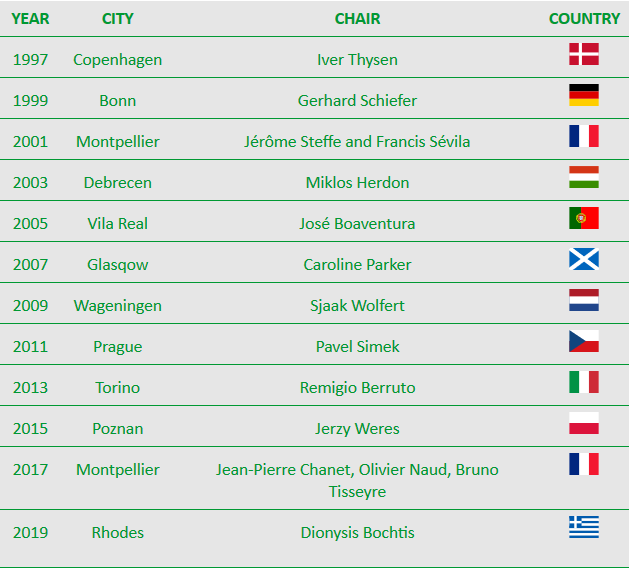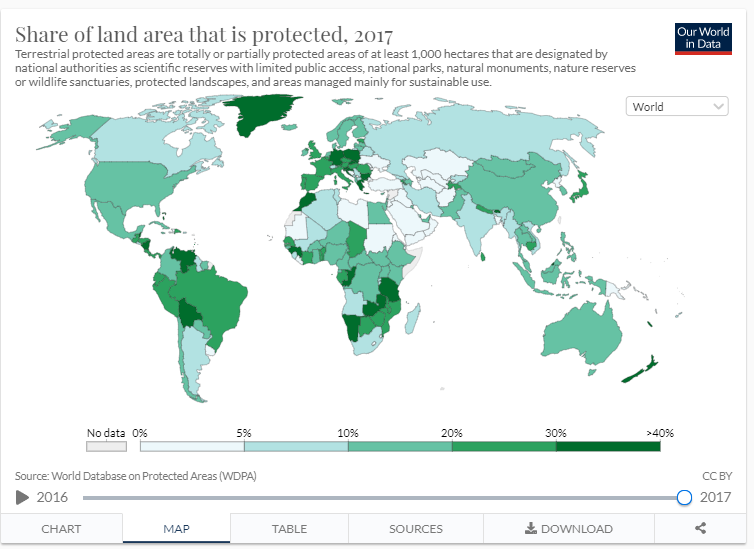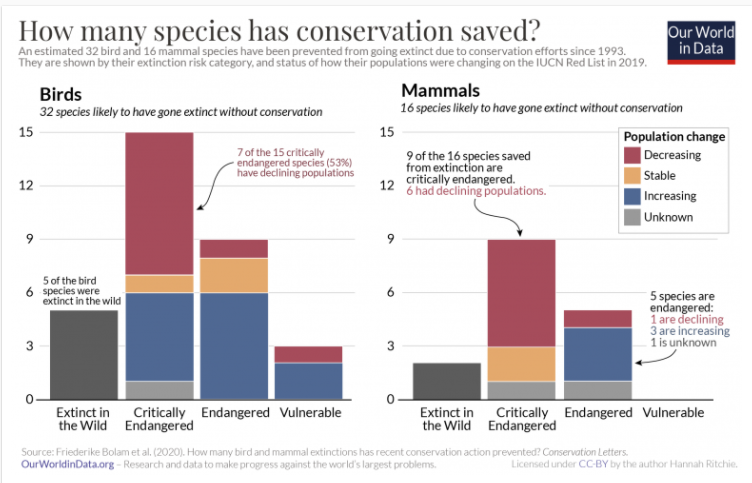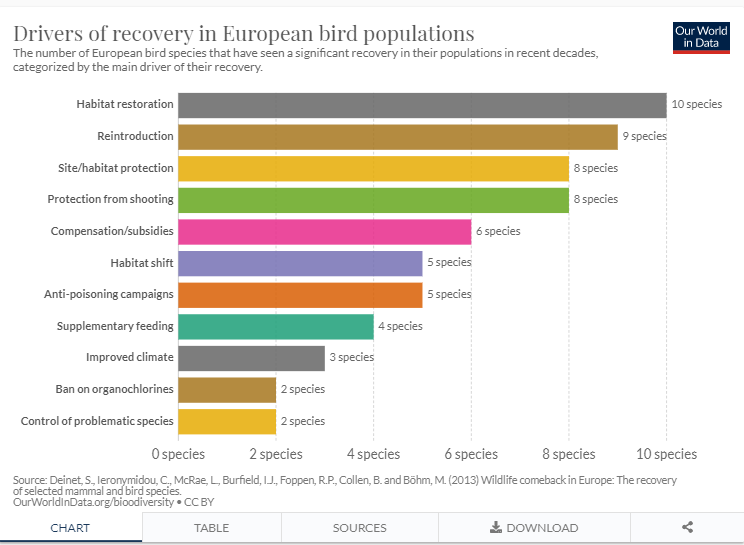|
You
can also view the message online
|
||||||||||||||
 Châtenay-Malabry (FR - 92290), 3 May, 2021 EFITA newsletter / 984 - European Federation for Information Technology in Agriculture, Food and the Environment Do not miss the Virus Jokes in English and French The informatique-agricole.org site now offers you the possibility of subscribing the RSS feeds of its two newsletters See RSS feeds to implement to ensure that you continue to receive this newsletter To unsubscribe this newsletter, please contact me directely: guy.waksman(a)laposte.net if this link Unsubscribe does not work. Please note that I changed the presentation of the links that are embedded in the name of the web service. 
To correspond with me (GW), please use this address: guy.waksman(a)laposte.net To subscribe the efita newsletter (please ask your friends and colleagues to test this link) Efita Newsletters subscription Efita 2021 Conference 25 -26 May 2021 - Digital Agriculture Web Conference The European Federation for Information Technology in Agriculture, Food and the Environment (EFITA) would like to invite you at the first EFITA International online Conference in 2021. As a way to keep the momentum and engagement of our society, while maintaining the plans for the 2022 physical EFITA conference, this conference and its format are planned as a response to the unpredictable situation created by the COVID-19. This event is an opportunity to bring together engineers, scientists, technicians, aca-demics and industry people in a new way to exchange knowledge, ideas, to present innovations and to discuss the state-of-the-art and future use of ICT in the agri-food sector and bio-resources production sectors. May 2021 EFITA Web conference participants: questionnaire about ICT in Agriculture (distributed since the 1997 Efita Conference) The 2021 replies with the earlier collated insights will enable finalising our 25 years questionnaire overview - planned to be presented at the EFITA 2022 conference. See Questionnaire Contacts: Ehud GELB and Gilad RAVID E-mail : ehud.gelb(a)mail.huji.ac.il Before computers... Weekly newsletters about ICT in Agriculture in English and French Both newsletters have around 14000 subscribers. >>> Last weekly EFITA Newsletters in English (created in 1999) Efita Newsletters >>> Last weekly AFIA Newsletters in French (created more than 20 years ago in 1997) Afia Newsletters >>> Statistics for the last efita newsletter >>> Last issue of the afia newsletter >>> Last available satistics for the afia newsletter SmartFarm (NL) At SmartFarm, we care about a more sustainable future of farming. We believe that by thinking smart, we can make farming become more ecological, profitable and sufficient. Our personal background in farming and our ability to bring together theoretical knowledge and practical experiences is what fuels this determination to make a difference. The agriculture-meteorologists in our research and develop department have generated a lot of knowledge about weather and crop protection in recent years. Fully automated, we calculate disease pressure for more than 40 crops and dozens of diseases and pests based on FieldMate sensor data. Due to the locally specified data collection of the FieldMate, we can provide you with very accurate data. This helps protect your crop better and increase your yield! See smartfarm.nl The FieldMate by SmartFarm: A simple solution for new challenges The world of farming has changed. Data is considered to be the solution for the newly arising challenges in the future of farming. But data is also stale. It needs to be put into perspective, for else it will be rather useless. This is where SmartFarm thinks beyond the natural limitations of data and where the FieldMate shines. The FieldMate is our all-in-one solution that does not simply only gather data. On the contrary, it transforms it into easily understandable information to support making the right decisions. To make sure that always the most accurate information for any possible problem is provided, the FieldMate measures data where it counts most: ultra-locally, directly between the plants. See smartfarm.nl Nothing is more responsible for the good old days than a bad memory: La récolte des pommes de terre de Jean-François Millet Autonomous seeder and planter projects With tractors being powerful enough and versatile as well, self-propelled seeders and planters haven’t really been able to break through like self-propelled sprayers have for instance. See futurefarming.com Precision irrigation: ‘Really move forward with precision irrigation in 2021’ Dutch grower Ronald Swinkels started with precision irrigation in 2020. How did it work for him? See futurefarming.com Agtech startup WaterBit names Tony Alvarez CEO WaterBit, specialised in automated precision irrigation, has appointed Tony Alvarez as the company’s new CEO. See futurefarming.com
Nothing is more responsible for the good old days than a bad memory: Le départ pour le travail de Jean-François Millet How did we the future yesterday?? See the incredible collection developed by Alain Fraval Farm management: Start-up uses AI and GPS to optimise on-farm logistics Agromizer offers a system to optimise on-farm routings to save time and reduce fuel consumption. See futurefarming.com Agtech adoption: Agriculture sets sights on space technologies Billion-dollar opportunities to super-charge technology adoption for farmers. See futurefarming.com Nothing is more responsible for the good old days than a bad memory: Cooper Tightening Staves on a Barrel, by Jean-Francois Millet (Museum of Fine Arts, Boston, United States) - Cerclage d'une barrique
PowerPollen’s ‘on-demand’ pollination tech could make bees’ lives easier, AFN, by Lauren Manning Pollination is a critical time for growers. Although there are a variety of technologies and services designed to get the job done, there are many wrinkles. First, the process can also be tedious, time-consuming, and expensive. Demand is increasing for bee-based pollination services, meaning there may not be enough rental bees to go around. And for many crops – including maize – pollination is reliant on hitting the exact right timeframe to ensure the female parts of one flower are receptive at the same time the male parts other flowers are releasing pollen. Iowa’s PowerPollen has developed a method for applying preserved or fresh pollen outside the window of natural pollination of maize seed. With PowerPollen’s “on-demand” pollination tech, the process is no longer reliant on the male plant’s daily shedding window of approximately three hours. .../... See agfundernews.com Nothing is more responsible for the good old days than a bad memory: La bergère de Jean-François Millet Cargill, Sysco invest $5m for sustainable grazing in the US Southern Great Plains, AFN, by Lauren Manning Sysco and Cargill have announced a new project in partnership with the National Fish and Wildlife Foundation (NFWF) that will invest a total of $5 million to support ranchers in the Southern Great Plains with the implementation of sustainable grazing practices. The Southern Great Plains, which touches Texas, Oklahoma, New Mexico, Kansas, and Colorado, is home to 30% of beef production in the US yet it faces severe challenges around extreme weather that have been amplified by climate change. The program is targeting 1 million acres and could sequester as much as 360,000 tons of carbon dioxide annually once implemented. It will also focus on habitat preservation in the region’s many migration corridors. See agfundernews.com Nothing is more responsible for the good old days than a bad memory (?????): Le vanneur de Jean-François Millet
Look at Leftovers to Reduce Food Waste The average American family loses $1,500 each year from uneaten food, according to the USDA’s Economic Research Service. Using leftover ingredients in meals can add nutrition and prevent waste. See tellus.ars.usda.gov EU to launch carbon farming framework by end-2021 following two-year study, AFN, by Jack Ellis The European Commission – the executive branch of the EU administration which is responsible for proposing bloc-wide legislation – has published the findings of its two-year study into creating a “carbon farming” framework for the EU. The Commission said it is aiming to launch an EU carbon farming initiative by the end of the year, based on the study’s findings and additional input from EU-funded projects, in order to incentivize agriculture, forestry, and land management operations across the region to sequester carbon. See agfundernews.com Drivers of recovery in European bird populations The Simon Abundance Index 2021: The Earth was 608 percent more abundant in 2020 than it was in 1980 Does population growth lead to greater resource scarcity, as argued by the English scholar Thomas Malthus and, more recently, by the Stanford University biologist Paul Ehrlich? Or does population growth make resources more abundant, as argued by the University of Maryland economist Julian Simon? The Simon Abundance Index measures the relationship between population growth and the abundance of 50 basic commodities, including food, energy, materials, minerals, and metals. Global resource abundance increased by 5.9 percent in 2020, according to the 4th annual Simon Abundance Index. The base year of the index is 1980, and the base value of the index is 100 percent. In 2020, the index reached 708.4 percent. In other words, the index rose by 608.4 percentage points over the last 40 years, implying a compound annual growth rate in resource abundance of around 5 percent and doubling of global resource abundance every 14 years or so. See humanprogress.org Explore how much the world has changed since you were born Is life getting better or worse? Watching the news, it’s easy to become pessimistic. But don’t forget that reporting is often selective. Bad news leads to higher ratings, while good news is seldom covered. So, what is the real state of humanity? Consider the changes that have occurred in the world over the last half-century. > In 1966, average life expectancy was only 56 years. In 2016, it was 72. That’s an increase of 29 percent. > Out of every 1,000 infants born, 113 died before their first birthday. In 2016, only 32 died. That’s a reduction of 72 percent. > Average income per person rose from $3,698 to over $17,469, or by 372 percent – and that’s adjusted for inflation. > The food supply rose from about 2,300 calories per person per day to over 2,800 calories, an increase of 22 percent, thus reducing hunger. > The length of schooling that a person could typically expect to receive was 4.15 years. In 2016, it was 8.71 years – a 110 percent increase. > On a scale from 0, which denotes autocracy, to 10, which denotes democracy, political freedom rose from 4.55 in 1966 to 7.05 in 2016. That’s an improvement of 55 percent. > Those are global improvements. What about life in your country? See humanprogress.org My Worst Forecasting Mistake, by Stephen S. Roach There were three seemingly strong reasons to predict last year that the US economy was headed for a double-dip recession. In the end, a confluence of three other reasons explains why that prediction turned out to be spectacularly wrong. .../... Basically, the shock turned out to be short-lived – also for three reasons: vaccines, human nature, and Bidenomics. Just as Americans signed up for shots, COVID infection rates plunged to just 26% of their early January peaks. That development, together with a sharply accelerated vaccination trajectory, pointed to sooner-than-expected herd immunity and a prompt end to the pandemic. Second, dismissing worrisome new COVID variants, impatient Americans and their compliant political leaders are breaking with recommended public health restrictions. And, third, the fiscal floodgates have been opened as never before: the $900 billion package of late 2020, followed by the $1.9 trillion American Rescue Plan in March, and now a proposed $2 trillion-plus of additional stimulus for infrastructure writ large dubbed the American Jobs Plan. With the end of COVID in sight, all this has turned into a powerful pro-cyclical fiscal stimulus, which, together with ongoing unprecedented monetary accommodation, has made the boom a one-way bet. And those ever-fickle economic indicators that were heading down late last year have now broken to the upside with a vengeance. In the end, the confluence of science, politics, and the indomitable human spirit left my out-of-consensus double-dip call in tatters. It wasn’t my first forecasting mistake, but it is probably the most glaring. Mea culpa is an understatement. Back to the ivory tower. See project-syndicate.org Explore how much the world has changed since you were born Is life getting better or worse? Watching the news, it’s easy to become pessimistic. But don’t forget that reporting is often selective. Bad news leads to higher ratings, while good news is seldom covered. So, what is the real state of humanity? Consider the changes that have occurred in the world over the last half-century. > In 1966, average life expectancy was only 56 years. In 2016, it was 72. That’s an increase of 29 percent. > Out of every 1,000 infants born, 113 died before their first birthday. In 2016, only 32 died. That’s a reduction of 72 percent. > Average income per person rose from $3,698 to over $17,469, or by 372 percent – and that’s adjusted for inflation. > The food supply rose from about 2,300 calories per person per day to over 2,800 calories, an increase of 22 percent, thus reducing hunger. > The length of schooling that a person could typically expect to receive was 4.15 years. In 2016, it was 8.71 years – a 110 percent increase. > On a scale from 0, which denotes autocracy, to 10, which denotes democracy, political freedom rose from 4.55 in 1966 to 7.05 in 2016. That’s an improvement of 55 percent. > Those are global improvements. What about life in your country? See humanprogress.org Telemedicine Is a Tool. Not a Replacement for Your Doctor’s Touch, by Elisabeth Rosenthal Covid-19 made virtual medicine a popular investment. But patients should beware. See NYT Nothing is more responsible for the good old days than a bad memory: Une bergère de Jean-François Millet
Why you won’t have to suffer to save the planet by Paul Krugman (NYT, April 27, 2021) Today’s column was about reasons right-wing politicians believe they can lie to their supporters about what the Biden administration is up to, especially although not only with regards to climate policy. As I said, the Republican line is that Democrats are going to take away all the good things in life, when the reality is that the Biden team is very much not calling for any serious crimping of Americans’ lifestyle. But why does the current administration imagine that we can save the planet without making major sacrifices? A lot of the answer has to do with extraordinary innovations in energy technology that have taken place over the past dozen years, innovations that make achieving a low-emission economy look like a medium-difficulty technical problem rather than something that will require drastic changes in the way we live. The cost of electricity from wind power has fallen 70 percent since 2009; the cost of electricity from solar panels has fallen 89 percent. Thinking about these developments, I remembered something I wrote back in 2010, when Democrats were trying unsuccessfully to push through legislation creating a cap-and-trade system to limit carbon emissions. The economic costs of such a system that model-builders estimated at the time were significant, although far from economy-killing. But I suggested that it was a good bet that the models overstated the economic costs of climate action, largely because they didn’t allow for creativity. Indeed, what we got was innovation that transformed the whole proposition. Now, you can’t always count on that kind of innovation coming along. A bit of autobiography here: I spent the summer of 1973, between my junior and senior years in college, working as a research assistant to William Nordhaus, who devised a brilliantly innovative way of modeling energy futures. (He later won the Nobel largely for his work integrating economic and climate models.) I passed most of that time in Yale’s Geology Library, rounding up the best available estimates of how much alternatives to fossil fuels, oil in particular, would cost; these estimates were crucial inputs into Bill’s model. Unfortunately, over the next several decades we would learn that the engineers responsible for these estimates were wildly overoptimistic: Oil prices rose well above the levels at which alternatives like shale oil were supposed to have been competitive, but the substitutes kept not appearing. Another of my teachers, Martin Weitzman — who should also have won a Nobel! — quipped that the cost of alternatives to crude oil was always 20 percent above the current price of crude, whatever that price happened to be. We used to call it Weitzman’s Law. Weitzman’s Law didn’t finally snap until after around 2009, when first fracking, then renewable energy, saw plunging costs and surging production. So we couldn’t have counted on renewable energy getting so cheap so fast. But it did. Claims by conservatives that policies to reduce emissions would kill the economy never made much sense, but anyone making those claims now is living in a time warp, ignoring the way the energy landscape has changed. The truth is that given current technology we can resolve the climate crisis without major changes in the way we live. No, we won’t have to give up meat. Although now that you mention it, meat alternatives have gotten immensely better over the past few years, and if you believe The Times’s food desk — which you should, it may be the best part of the paper! — vegan cheese is getting seriously good. Innovation isn’t just about energy production. In other words, we can eat, drink and be merry while still saving the planet. Enjoy your grilled brussels sprouts. Received in my mailbox April 27, 2021 - GW See NYT
Biden releases more details of American Families Plan for family farms During his first joint address to Congress last night, President Joe Biden highlighted the progress the United States has made on pandemic recovery and laid out his strategy to create additional jobs and lift more families out of poverty. The key to that strategy is his American Families Plan, a comprehensive package that would invest $1.8 trillion in education, childcare, nutrition assistance, and paid leave. The American Families Plan includes critical tax reform to ensure that the wealthy pay what he calls their “fair share” of taxes in order to finance essential investments in workers and families, including childcare, nutrition, higher education, and more. One of those overhauls is a change in the way capital gains are treated in our tax system so that, for people making over $1 million, the tax system no longer favors income from wealth over income from work. The plan won’t raise taxes on anyone making less than $400,000 a year. Part of Biden’s plan to make sure the wealthy pay more in taxes is a proposal to close the “stepped-up basis” loophole for wealthy estates so that enormous fortunes do not completely escape taxation. Under the proposal, unrealized capital gains (those that have never been previously taxed) are taxed at death above $2 million in gains per couple. However, the U.S. Department of Agriculture points out how this largely won’t affect family farms that stay in the family. …/… See agdaily.com Virginia Apgar: The Apgar Score (Heroes of Progress / Ep. 22) Our Hero of Progress is Virginia Apgar, an American anesthesiologist and medical researcher who created a test that is used to quickly assess the health of new-born babies and to determine whether infants need immediate neonatal medical care. The test, which is named the ‘Apgar Score’ continues to be used as a standard practice across the world and it is credited with saving the lives of millions of babies since 1952. See vidéo Nothing is more responsible for the good old days than a bad memory: Bergères assises à l'ombre par Jean-François Millet The rabbi joke A synagogue has a mice problem. The custodian tries traps, bait, mice, everything. Nothing works. Finally, he goes to the rabbi and explains the problem. “I have the solution,” the rabbi says. “Well, what is it?” says the custodian. “It’s a foolproof plan,” the rabbi says, smiling. “I’ll give them all Bar Mitzvahs — we’ll never see them again!”. Nothing is more responsible for the good old days than a bad memory: Les botteleurs de foin, de Jean-François Millet The distribution of this efita newsletter is sponsored by vitisphere.com Please, contribute to the content of your efita newsletter, and advertise your events, new publications, new products and new project in this newsletter. Without your support, it will not survive! Contact: Guy WAKSMAN E-mail: guy.waksman(a)laposte.net To read this newsletter on our web site See Afia The archives of this newsletter See Afia About the EFITA mailing list You can use the efita moderated list (> 15000 subscribers) to announce any event / product / web site / joke (!) related to IT in agriculture, environment, food industry and rural areas. If you want to subscribe a friend, please fill in his form. If you do not wish to receive our messages, please fill in the following form... |

















